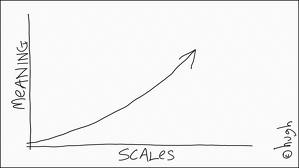Dr. Robert Emmons, a prolific researcher and professor at the University of California, recently wrote:
“As far as we know, humans are the only meaning-seeking species on the planet. ‘Meaning- making’ is an activity that is distinctively human, a function of how the human brain is organized.
The many ways in which humans conceptualize, create, and search for meaning has become a recent focus of behavioral science on the quality of life and subjective well-being.”
 A
tremendous amount of research and writing on the connection between human
performance and the meaning people find in their work has started to emerge
because of this focus. And, some of the
heavy-hitters in the business world were quick to take notice of these
discoveries.
A
tremendous amount of research and writing on the connection between human
performance and the meaning people find in their work has started to emerge
because of this focus. And, some of the
heavy-hitters in the business world were quick to take notice of these
discoveries.
Here are some examples of how much attention is being paid to “meaning-making” at work:
- Research at McKinsey and Company has led to actionable strategies and tasks that help infuse meaning in the work of individuals and organizations. These findings were based on research done by social scientists. Their full perspective and recommendations can be found in Beyond Performance: How Great Organizations Build Ultimate Competitive Advantage
- Gary Hamel, ranked by the Wall Street Journal as the world’s most influential business thinker, and who Fortune magazine called “the world’s leading expert on business strategy" is encouraging managers to see themselves as “entrepreneurs of meaning.”
- One of my favorite psychological researchers, Mikel Csìkszentmihàlyi, writes extensively about “the making of meaning” in his book Good Business.
I want to emphasize that the research being done in this area is far from the touchy-feely anecdotes or inspirational speaker clichés that sometimes sound similar. I have little tolerance for methods and insights that are not based on research. Once you push through the surface language, there is substance behind this topic that leads to real and measurable performance improvements.
There is far too much to share with you about this subject matter in one blog edition, but here are a few examples that will get you thinking about the importance of meaning at work. These examples were compiled by Susie Cranston and Scott Keeler at McKinsey and Company:
1. Emerson Electric
"David Farr, chairman and CEO of Emerson Electric.... is known for asking virtually everyone he encounters in the organization four questions:
(a) How do you make a difference? (testing for alignment with the company’s direction)
(b) What improvement idea are you working on? (emphasizing continuous improvement)
(c) When did you last get coaching from your boss? (emphasizing the importance of people development)
(d) Who is the enemy? (emphasizing the importance of 'One Emerson' and no silos, as well as directing the staff’s energy toward the external threat).
The motivational effect of this approach has been widely noted by Emerson employees."
2. Wells Fargo
"The CEO of Wells Fargo, John Stumpf, marked the first anniversary of its change program by sending out personal thank-you notes to all the employees who had been involved, with specific messages related to the impact of their individual work."
3. PepsiCo
"Indra Nooyi, CEO of PepsiCo, sends the spouses of her top team handwritten thank-you letters. After seeing the impact of her own success on her mother during a visit to India, she began sending letters to the parents of her top team, too.
Some managers might dismiss these as token gestures—but employees often tell us that the resulting boost in motivation and in connection to the leader and the company can last for months if not years.
As Sam Walton, founder of Wal-Mart Stores, put it, 'Nothing else can quite substitute for a few well-chosen, well-timed, sincere words of praise. They’re absolutely free—and worth a fortune.'”
Don't get me wrong, working hard and expecting everyone else match your level of effort can be a powerful motivator. However, that philosophy has limitations.
As human beings, we need more. Science is telling us that the “more” we’re looking for is meaning in our work. Make sure your agents and employees understand and buy-into the meaning behind their tasks. If they don’t, they’ll not reach their maximum potential and your team will suffer.
Question: How do you help infuse your organization with meaning? What communication techniques have you tried and found effective?
Join the WorkPuzzle Discussion at the Tidemark Online Community (TMOC)
Engage in the WorkPuzzle discussion by joining the TMOC private social network. Commenting on a public blog like WorkPuzzle can be a little intimidating, so why not join the discussion inside the privacy of the TMOC discussion group?
By joining TMOC, you'll get to see who else is in the group and your comments will only be seen by those whom you trust. Joining TMOC is quick, easy, and free (no kidding…this takes less than 2 minutes). To get started, click here.
Already of a member of TMOC? If so, join the WorkPuzzle Dialog Group by clicking on the WorkPuzzle Group icon on the left side of your TMOC homepage. Questions? Email the WorkPuzzle editor (workpuzzle@hiringcenter.net) and we'll walk through the process.
 Editor's Note: This article was written by Dr. David Mashburn. Dave is a Clinical and Consulting Psychologist, a Partner at Tidemark, Inc. and a regular contributor to WorkPuzzle.
Editor's Note: This article was written by Dr. David Mashburn. Dave is a Clinical and Consulting Psychologist, a Partner at Tidemark, Inc. and a regular contributor to WorkPuzzle.




Comments